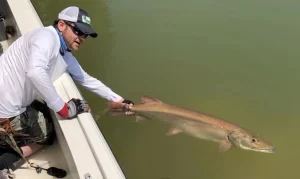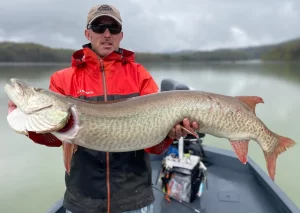Landing a monster musky is a challenge many anglers aspire to conquer, but it doesn’t have to be overly complicated. This guide provides essential tips, from tackle to tactics, for those looking to catch one of these elusive giants.
Understanding Muskies: The Challenge

Muskies, often called the “fish of 1,000 casts,” are notoriously difficult to catch. Unlike their more aggressive cousins, the chain pickerel and northern pike, muskies are selective feeders with a slower metabolism. Their feeding windows are influenced by various factors, including water conditions, weather, and moon phases. As muskies grow larger, they become even more selective, often targeting large prey like suckers, trout, and small carp. This selectivity means that success in muskie fishing comes down to timing and presenting the right lure at the right moment.
Choosing the Right Gear
While it’s possible to catch muskies on lighter rods and reels, it’s not recommended. A stout rod is essential for casting larger lures and achieving the forceful hookset needed to penetrate a muskie’s hard jaws. A heavy-power baitcasting rod in the 7’6” to 8-foot range is ideal for both boat and shore fishing. Pair this with a muskie-specific baitcasting reel with a high rate of retrieve to handle heavier line and quickly pick up slack if the fish runs. Most experienced muskie anglers opt for 50- to 65-pound braided line, though 30- to 40-pound braid can suffice for those using lighter lures. A bite leader, either heavy fluorocarbon or steel, is also crucial to prevent a muskie’s sharp teeth from cutting through the line.
Top Muskie Lures
Muskie lures come in a variety of styles, each with its unique appeal. In-line spinners, also known as bucktails, are effective year-round, particularly in warmer waters where muskies are more active. Diving plugs are ideal for targeting muskies in deeper water, especially during the colder months. Glide baits, which sway side to side underwater, have gained popularity for their lifelike action. Soft-plastic swimbaits offer versatility, allowing anglers to fish at various depths, while topwaters provide an exhilarating experience when a muskie strikes at the surface.
Seasonal Muskie Fishing Tactics
- Spring: Muskies feed heavily before spawning, making it an excellent time to target them in deeper water near baitfish schools.
- Summer: Muskies gravitate towards weedy areas in 3- to 8-feet of water. This season is perfect for using loud topwaters or bucktails, but anglers should avoid targeting muskies when water temperatures exceed 70 degrees to prevent stressing the fish.
- Fall: As waters cool, muskies become more aggressive, feeding heavily to prepare for winter. This is the prime time for using a variety of lure styles, including topwaters on warmer days.
- Winter: In colder regions, muskies move to deep holes or eddies in rivers where food is abundant. Slow, methodical presentations are key to enticing a bite during this season.

The Importance of the Figure-8 Technique
One of the most critical techniques in muskie fishing is the figure-8. Muskies often follow lures up to the boat, making it essential to keep an eye on the lure until the last moment. A quick change in the lure’s direction, achieved by sweeping the rod underwater in a figure-8 pattern, can entice a muskie to strike right at the boat. This technique, while challenging, is often the difference between a missed opportunity and landing a trophy muskie.
Muskie fishing requires patience, dedication, and the right gear, but the reward of landing one of these elusive giants makes the effort worthwhile. By following these tips and techniques, anglers can increase their chances of success and enjoy the thrill of muskie fishing.
Images/Source: F&S





